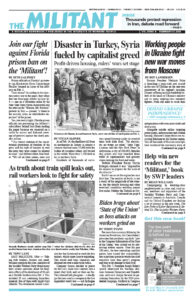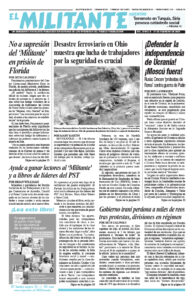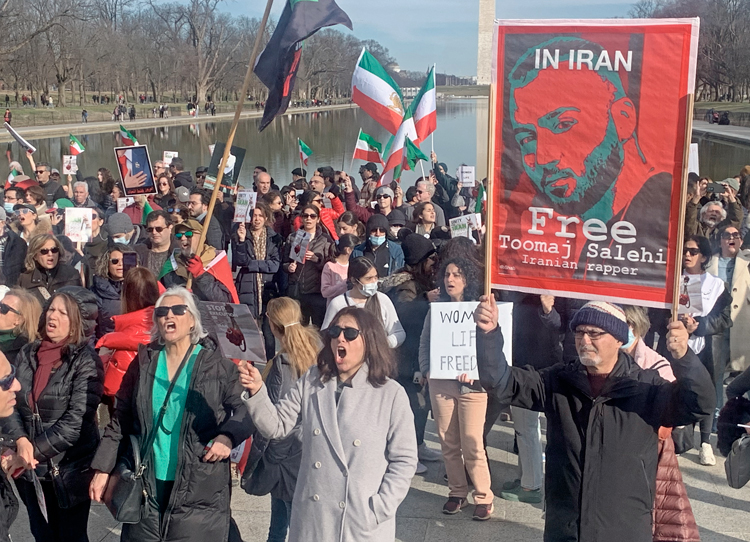WASHINGTON — Several thousand people rallied here Feb. 11, part of an international day of action to protest the ongoing repression by the reactionary bourgeois-clerical regime in Iran. Participants came from across the East Coast and from as far away as Houston. There were similar protests in Los Angeles, Chicago and Paris.
Among the signs were ones saying “Women, life, freedom,” one of the key slogans in the protests in Iran, and “For a secular, democratic, non-nuclear Iran.” Others displayed photos of political prisoners in Iran, as well as those of four protesters executed by the Iranian government on charges of “enmity to God.”
“My mother was caught by the morality police three times for improperly wearing the hijab. The last time she was locked in Tehran’s Evin prison,” store owner Sariayah Cheharzai, who came to the march from Detroit, told the Militant. The Iranian upsurge began after the regime’s notorious “morality” police arrested Zhina Amini, who died three days later.
“My grandfather put up the deed to his house so that my mother could flee the country,” Cheharzai said.
One group of Iranians who came to the Chicago protest carried signs with a photo of Tyre Nichols, who was beaten to death by cops in Memphis in January, and opposing police brutality. The sign also said, “No superpowers invasion in Iran.” They told the Militant that the struggle for freedom in Iran had to be carried out by the Iranian people, and they opposed any intervention by Washington, or by Moscow or Beijing.
Some protesters here carried signs that said, “The 1979 insurrection was the cause of today’s poverty,” blaming the popular movement of millions that overthrew the bloody dictatorship of the U.S.-backed shah, Mohammad Reza Pahlavi, for the repressive regime headed by Supreme Leader Ayatollah Ali Khamenei today.
That shah’s son, Reza Pahlavi, who calls himself the crown prince, appeared on the stage at the protest in L.A.
In fact, the government that rules Iran today is the result of a bloody counterrevolution. It was consolidated in 1983 based on attacking the rights won by working people and oppressed nationalities in the 1979 revolution.
“I left Iran in 1983 when it got harder and harder to say what you thought. We want freedom,” Nader Aziz, an engineer from Virginia, told Chris Hoeppner, a rail worker and member of the Socialist Workers Party, at the rally here. Hoeppner asked him about the posters in the crowd supporting Reza Pahlavi. “He says he’s for democracy and anything would be better than the government we have now,” Aziz said.
“Reza Pahlavi is covering up the brutality of the dictatorship under the shah,” Hoeppner responded. “Workers and farmers in Iran need to look toward a new revolution, like took place in 1979, and to taking political power.”
In the Baluchistan region of Iran, where weekly protests of thousands continue, a common chant is “No monarchy, no Supreme Leader! We want democracy. Equality.”
The Baluch people have never forgotten how the shah’s hated Savak political police tortured tens of thousands of his opponents and viciously attacked those who were fighting for equal rights for Kurds, Baluchs, Arabs, Azerbaijanis, Turkmen and other oppressed nationalities of Iran. Their fight was an important part of the 1979 revolution.
Naomi Craine in Chicago contributed to this article.


